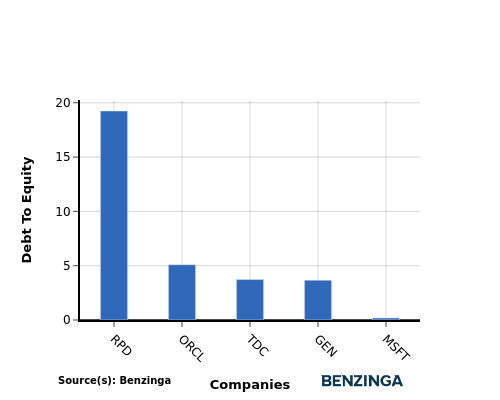Insights Into Microsoft's Performance Versus Peers In Software Sector
In the dynamic and fiercely competitive business environment, conducting a thorough analysis of companies is crucial for investors and industry enthusiasts. In this article, we will perform an extensive industry comparison, evaluating Microsoft (NASDAQ:MSFT) in relation to its major competitors in the Software industry. By closely examining crucial financial metrics, market position, and growth prospects, we aim to offer valuable insights for investors and shed light on company's performance within the industry.
Microsoft Background
Microsoft develops and licenses consumer and enterprise software. It is known for its Windows operating systems and Office productivity suite. The company is organized into three equally sized broad segments: productivity and business processes (legacy Microsoft Office, cloud-based Office 365, Exchange, SharePoint, Skype, LinkedIn, Dynamics), intelligence cloud (infrastructure- and platform-as-a-service offerings Azure, Windows Server OS, SQL Server), and more personal computing (Windows Client, Xbox, Bing search, display advertising, and Surface laptops, tablets, and desktops).
| Company | P/E | P/B | P/S | ROE | EBITDA (in billions) | Gross Profit (in billions) | Revenue Growth |
|---|---|---|---|---|---|---|---|
| Microsoft Corp | 39.61 | 11.83 | 14.18 | 8.27% | $40.71 | $48.15 | 13.27% |
| Oracle Corp | 57.08 | 34.02 | 12.37 | 18.43% | $6.83 | $11.16 | 11.31% |
| ServiceNow Inc | 123.99 | 18.71 | 17.11 | 3.65% | $0.65 | $2.49 | 22.38% |
| Palo Alto Networks Inc | 117.53 | 18.86 | 16.32 | 3.85% | $0.4 | $1.67 | 15.33% |
| Fortinet Inc | 43.16 | 40.90 | 13.21 | 25.08% | $0.56 | $1.25 | 13.77% |
| Gen Digital Inc | 29.63 | 8.34 | 4.84 | 6.43% | $0.53 | $0.81 | 4.77% |
| Monday.Com Ltd | 284.06 | 13.26 | 14.42 | 2.57% | $0.01 | $0.25 | 30.12% |
| Dolby Laboratories Inc | 28.86 | 2.84 | 5.62 | 3.61% | $0.14 | $0.33 | 1.38% |
| CommVault Systems Inc | 97.28 | 22.38 | 7.42 | 10.11% | $0.03 | $0.23 | 23.17% |
| Qualys Inc | 28.08 | 10.01 | 8.20 | 9.75% | $0.06 | $0.13 | 9.67% |
| Teradata Corp | 15.96 | 13.62 | 1.29 | 30.24% | $0.09 | $0.25 | -10.11% |
| Progress Software Corp | 38.07 | 4.71 | 2.53 | 3.85% | $0.08 | $0.19 | 35.57% |
| N-able Inc | 104.12 | 2.03 | 3.34 | -0.93% | $0.01 | $0.09 | 3.91% |
| Rapid7 Inc | 55.24 | 27.60 | 1.68 | 5.98% | $0.02 | $0.15 | 2.51% |
| Average | 78.7 | 16.71 | 8.33 | 9.43% | $0.72 | $1.46 | 12.6% |
By closely studying Microsoft, we can observe the following trends:
-
The Price to Earnings ratio of 39.61 is 0.5x lower than the industry average, indicating potential undervaluation for the stock.
-
With a Price to Book ratio of 11.83, significantly falling below the industry average by 0.71x, it suggests undervaluation and the possibility of untapped growth prospects.
-
The Price to Sales ratio of 14.18, which is 1.7x the industry average, suggests the stock could potentially be overvalued in relation to its sales performance compared to its peers.
-
The Return on Equity (ROE) of 8.27% is 1.16% below the industry average, suggesting potential inefficiency in utilizing equity to generate profits.
-
The Earnings Before Interest, Taxes, Depreciation, and Amortization (EBITDA) of $40.71 Billion is 56.54x above the industry average, highlighting stronger profitability and robust cash flow generation.
-
The company has higher gross profit of $48.15 Billion, which indicates 32.98x above the industry average, indicating stronger profitability and higher earnings from its core operations.
-
The company is experiencing remarkable revenue growth, with a rate of 13.27%, outperforming the industry average of 12.6%.
Debt To Equity Ratio

The debt-to-equity (D/E) ratio is a key indicator of a company's financial health and its reliance on debt financing.
Considering the debt-to-equity ratio in industry comparisons allows for a concise evaluation of a company's financial health and risk profile, aiding in informed decision-making.
In light of the Debt-to-Equity ratio, a comparison between Microsoft and its top 4 peers reveals the following information:
-
Microsoft exhibits a stronger financial position compared to its top 4 peers in the sector, as indicated by its lower debt-to-equity ratio of 0.19.
-
This suggests that the company has a more favorable balance between debt and equity, which can be seen as a positive aspect for investors.
Key Takeaways
For Microsoft in the Software industry, the PE and PB ratios suggest that the stock is undervalued compared to its peers. However, the high PS ratio indicates that the stock may be overvalued based on revenue. In terms of ROE, Microsoft's performance is lower than its peers, while its high EBITDA and gross profit margins indicate strong operational efficiency. Additionally, the high revenue growth rate suggests potential for future expansion and market dominance.
This article was generated by Benzinga's automated content engine and reviewed by an editor.
Posted-In: BZI-IANews Markets Trading Ideas


